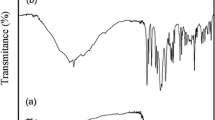Abstract
Polycrystalline metallic copper nanoparticle samples with the average particle sizes ranging from 53 to 80 nm were controllably prepared by the wet chemical reduction of copper hydroxide with hydrazine hydrate at 50 °C for 1–4 h. The small-sized copper nanoparticles exhibited a higher catalytic activity than the large-sized ones in the hydrogenation of 1-nitroanthraquinone with gaseous hydrogen to 1-aminoanthraquinone at the reaction temperatures of 180–220 °C. When the hydrogenation reaction was conducted at 200 °C and H2 pressures of 0.3–0.7 MPa, the copper nanoparticles with the average particle size of 53 nm exhibited the selectivity of 1-aminoanthraquinone of above 88% at the conversion of 1-nitroanthraquinone of above 95%. A power type reaction kinetics equation well fit the experimental data and the simulated activation energy is 51 kJ mol−1.
Graphical abstract








Similar content being viewed by others
References
An B, Zhang J, Cheng K, Ji P, Wang C, Lin W (2017) Confinement of ultrasmall Cu/ZnOx nanoparticles in metal-organic frameworks for selective methanol synthesis from catalytic hydrogenation of CO2. J Am Chem Soc 139:3834–3840
Baran NY (2020) Generation and characterization of palladium nanocatalyst anchored on a novel polyazomethine support: application in highly efficient and quick catalytic reduction of environmental contaminant nitroarenes. J Mol Struct 1220:128697
Baturina OA, Lu Q, Padilla MA, Xin L, Li W, Serov A, Artyushkova K, Atanassov P, Xu F, Epshteyn A, Brintlinger T, Schuette M, Collins GE (2014) CO2 electroreduction to hydrocarbons on carbon-supported Cu nanoparticles. ACS Catal 4:3682–3695
Chetty T, Dasireddy VDBC, Callanan LH, Friedrich HB (2018) Continuous flow preferential hydrogenation of an octanal/octene mixture using Cu/Al2O3 catalysts. ACS Omega 3:7911–7924
Chi P (2012) Synthesis of anthraquinone dye intermediates by liquid phase indirect electrolysis oxidation. Masteral Dissertation, Dalian University of Technology. https://cdmd.cnki.com.cn/Article/CDMD-10141-1012395346.htm
Das A, Deshagani S, Ghosal P, Deepa M (2020) Redox active and electrically conducting cobalt telluride nanorods/poly(1-aminoanthraquinone) composite and photoactive Rose Bengal dye based photo-supercapacitor. Appl Mater Today 19:100592
Dasireddy VDBC, Likozar B (2019) The role of copper oxidation state in Cu/ZnO/Al2O3 catalysts in CO2 hydrogenation and methanol productivity. Renew Energ 140:452–460
Duan YX, Meng FL, Liu KH, Yi SS, Li SJ, Yan JM, Jiang Q (2018) Amorphizing of Cu nanoparticles toward highly efficient and robust electrocatalyst for CO2 reduction to liquid fuels with high Faradaic efficiencies. Adv Mater 30:1706194
Feng X, Huang H, Du C, Wang X, Wang R, Song W (2015) 1-Aminoanthraquinone bridged small Pt nanoparticles on carbon nanotubes as efficient electrocatalysts. Appl Surf Sci 356:1306–1313
Gawande MB, Goswami A, Felpin FX, Asefa T, Huang X, Silva R, Zou X, Zboril R, Varma RS (2016) Cu and Cu-based nanoparticles: synthesis and applications in catalysis. Chem Rev 116:3722–3811
Han J, Liu Y (2001) Synthesis of 1-aminoanthraquinone. Henan Chem Ind 8:10–11
He L, Wang LC, Sun H, Ni J, Cao Y, He HY, Fan KN (2009) Efficient and selective room-temperature gold-catalyzed reduction of nitro compounds with CO and H2O as the hydrogen source. Angew Chem 121:9702–9705
Hou Z (1995) Preparation of 1-aminoanthraquinone by sulfonation ammoniation. Hebei Chem Ind 4:22–23
Huś M, Dasireddy VDBC, Štefančič NS, Likozar B (2017) Mechanism, kinetics and thermodynamics of carbon dioxide hydrogenation to methanol on Cu/ZnAl2O4 spinel-type heterogeneous catalysts. Appl Catal B 207:267–278
Nikoofard H, Masdarolomoor F, Falahatkar M, Amin AH (2015) Electro-chemical preparation and characterization of poly(1-amino-9,10-anthraquinone) films in a micelle solution of sodium dodecyl sulfate. Synthetic Met 209:212–219
Pan W, Qian C, Chen X (2011) Synthesis of 1-aminoanthraquinone with a pipeline reactor. Chem World 52:362–364
Reske R, Mistry H, Behafarid F, Cuenya BR, Strasser P (2014) Particle size effects in the catalytic electroreduction of CO2 on Cu nanoparticles. J Am Chem Soc 136:6978–6986
Song J, Huang ZF, Pan L, Li K, Zhang X, Wang L, Zou JJ (2018) Review on selective hydrogenation of nitroarene by catalytic, photocatalytic and electrocatalytic reactions. Appl Catal b: Environ 227:386–408
Tao W, Wang YH (2020) Interaction between Pd and Cu nanoparticles in bimetallic CuPdx nanoparticles and its impact on oxidation of 1,2-propanediol to aliphatic acids. Chinese J Chem Eng 28:1085–1094
Wang A, Liu M, Yin H (2020) Synthesis of bimetallic Cu/Ni nanoparticles for selective hydrogenation of 1-nitroanthraquinone with gaseous H2 to 1-aminoanthraquinone. Colloid Surf A 601:125021
Wang A, Ye C, Jia X, Yin H (2021) Methanol dehydrogenation to methyl formate catalyzed by Cu/SiO2 catalysts: impact of precipitation procedure and calcination temperature. Russ J Appl Chem 94:1302–1312
Zhang H, Sun H, Huang M (2014) Preparation of 1-aminoanthraquinone by catalytic hydrogenation on Pd/Al2O3 catalyst. Adv Fine Petrochem 15:40–43
Zheng D, Tian S, Wu C, Lu J, Li W (2017) Preparation of 1-aminoanthraquinone by catalytic hydrogenating 1-nitroanthraqllinone with Pd/C catalyst. Fine Specialty Chem 25:29–32
Funding
The present work was financially supported by funds of the Vice President of Science and Technology of Jiangsu Province, China (FZ20180919) and the Danyang Science and Technology Bureau, China (SF201803).
Author information
Authors and Affiliations
Contributions
AW: conceptualization, methodology, formal analysis, investigation, data curation, original draft preparation, review and editing, and funding acquisition.
DY: investigation, data curation, and original draft preparation.
HY: conceptualization, supervision, project administration, reviewing results and the manuscript, and funding acquisition.
Corresponding author
Ethics declarations
Conflict of interest
The authors declare that they have no conflict of interest.
Additional information
Publisher's note
Springer Nature remains neutral with regard to jurisdictional claims in published maps and institutional affiliations.
Rights and permissions
About this article
Cite this article
Wang, A., Yu, D. & Yin, H. Hydrogenation of 1-nitroanthraquinone to 1-aminoanthraquinone with gaseous H2 catalyzed by copper nanoparticles and reaction kinetics. J Nanopart Res 24, 77 (2022). https://doi.org/10.1007/s11051-022-05444-0
Received:
Accepted:
Published:
DOI: https://doi.org/10.1007/s11051-022-05444-0




